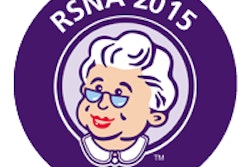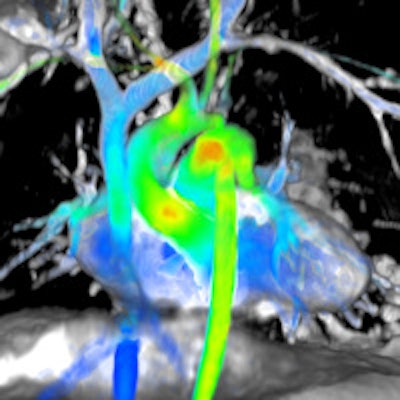
CHICAGO - The launch of a new service for analyzing healthcare data in the cloud is spearheading the product introductions by GE Healthcare at this week's RSNA 2015 meeting. Other introductions include new ultrasound and CT systems.
Imaging informatics
GE made a major play in the big-data segment with the launch of GE Health Cloud at RSNA 2015, a new healthcare IT platform designed to enable medical facilities to perform data analytics and other functions more efficiently in the cloud.
GE Health Cloud is built around the company's Predix industrial Internet platform, along with a group of healthcare-specific apps developed by GE and other companies for specific tasks.
GE is highlighting four main areas for Health Cloud in its RSNA booth. The first is the ability of Health Cloud to give users cloud-based access to GE's Advantage Workstation (AW) software for 3D imaging and postprocessing.
The platform can also be used to help institutions prepare for multidisciplinary team meetings that can connect staff across multiple locations, cutting the amount of time required to prepare for meetings by 20%.
Health Cloud offers a more robust and scalable platform for exchanging cases between medical practitioners, regardless of their institutional affiliation, and CDs no longer have to be used for case exchange.
Finally, Health Cloud provides more efficient access to patient images, helping to create a longitudinal record for imaging and related patient data. GE is showing Health Cloud apps in its RSNA booth, with a full commercial launch expected in the first half of 2016.
GE is also highlighting recent enhancements to its Universal Viewer application for enterprise-wide image viewing, including 19 integrated applications, and the company is integrating its AW workstation software into Universal Viewer.
Meanwhile, GE is launching Centricity Analytics at the show, support for pathology images, and an update to its AW VolumeShare 7 software. The company noted that it is moving more of its core applications to the cloud.
CT
In the CT section of its booth, GE is highlighting Revolution CT ES, a new lower-cost version of its flagship Revolution CT platform designed for emergency room use. The new system sports 80 mm of coverage, compared with the 160 mm found on the high-end Revolution CT model. But it features the same 256-detector-row configuration found on the higher-end system, and customers can upgrade to 160-mm coverage in the future by swapping out detectors.
On the Revolution HD platform, GE is demonstrating a metal artifact reduction (MAR) protocol called Smart MAR, and it is also talking about its CT lung cancer screening protocol, for which it received U.S. Food and Drug Administration (FDA) clearance earlier in the year.
On the software side, DoseWatch Explore is a radiation dose management and optimization application that is Web-based and can be deployed over the cloud. The application lets sites track, analyze, and report on dose for their GE scanners, collecting data directly from the modality scanner and presenting it to users via a Web application so they can easily make changes to scanning protocols to reduce dose.
MRI
In MRI, GE is highlighting ViosWorks, a cloud-based cardiac MR visualization and reporting package that captures 3D spatial and velocity data at every time point during the cardiac cycle, producing high-resolution images of the beating heart and measuring the speed and direction of blood flow at each time point.
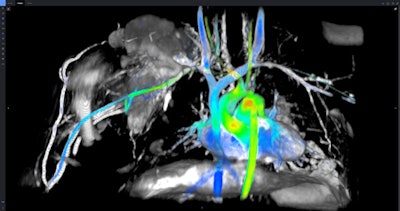 ViosWorks combines 3D cardiac anatomy, function, and flow in a single free-breathing scan.
ViosWorks combines 3D cardiac anatomy, function, and flow in a single free-breathing scan.The platform simplifies cardiac exams for patients because it allows for a single free-breathing scan; it also eliminates the need for slice positioning and reduces exam time from more than 60 minutes to 10 minutes or less. Because it is built on GE's cloud-based Arterys software, users can evaluate large datasets in real-time, according to the firm. GE expects ViosWorks to be commercially available in 2016.
The company is also highlighting three MRI scanners it launched last year at RSNA: Signa Pioneer, its flagship 3-tesla unit, and Signa Creator and Signa Explorer, both 1.5-tesla devices.
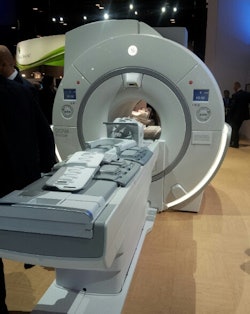 Signa Voyager is a work-in-progress 1.5-tesla MRI scanner.
Signa Voyager is a work-in-progress 1.5-tesla MRI scanner.Pioneer received 510(k) clearance from the FDA in July and the CE Mark in August. It features GE's magnetic resonance image compilation (MAGiC) and SilentScan protocols, as well as its total digital imaging (TDI) package, which improves image quality and increases signal-to-noise ratios by up to 25%. MAGiC received the CE Mark in August but has not yet been cleared by the FDA.
Both Creator and Explorer use 34% less power than GE's previous generation MR and were FDA-cleared in March. Creator offers "eyes to thighs" coverage, automated motion correction for brain imaging, cartilage mapping for musculoskeletal studies, and vascular scans with noncontrast and automated time-resolved protocols. Explorer includes these features as well as SilentScan for brain imaging and MAVRIC SL, a tool that improves visualization of soft tissue.
Also on the MR side, GE is showcasing Signa Explorer Lift, an in-field upgrade program for its 1.5-tesla systems. The program allows facilities with currently installed 1.5-tesla GE scanners to rebuild their existing magnet, saving up to 50% in construction and equipment cost compared to purchasing a new GE 1.5-tesla system, and increasing procedure volume by 30% due to more efficient workflow, the company said.
Finally, GE is highlighting Signa Voyager, a work-in-progress unit that will give users lower price-point access to a 1.5-tesla wide-bore MR by reducing operational costs and offering easier siting requirements. Signa Voyager will include most of the applications available with Signa Pioneer.
Interventional and x-ray
GE has created a new family of interventional x-ray software packages, called Assist, that are designed to help subspecialists perform complex endovascular procedures more easily.
One of the applications that GE has added to the Assist family is FlightPlan for Liver, which provides what GE calls directed workflow for liver embolization procedures, walking users step by step through studies performed on the company's flagship Discovery IGS 740 angiography system.
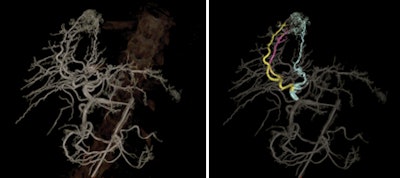 Interventional images demonstrate before (left) and after (right) the use of FlightPlan for Liver.
Interventional images demonstrate before (left) and after (right) the use of FlightPlan for Liver.FlightPlan for Liver is designed to address challenges involved in delivering therapeutic drugs during transarterial chemoembolization (TACE) therapy, where identifying the liver's vessels accurately is key. This can be complicated by the liver's complex vasculature, which can make it hard to identify tumor-feeding vessels in 2D and 3D images.
The application automatically highlights vessels traveling from the catheter tip to the area of a hypervascular lesion. It can also work with vessels identified as 3D roadmaps on the company's Innova Vision option.
Another new application, Vessel Assist, is designed for procedures to clear chronic total occlusions, as well as transjugular intrahepatic portosystemic shunt (TIPS) procedures. Other applications include bone interventions, vascular surgery, interventional cardiology, and interventional oncology.
In traditional radiography, GE is demonstrating a novel tool in which booth attendees are able to tour a virtual radiography department using virtual reality glasses.
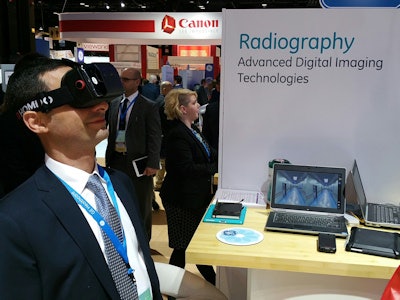 GE is giving RSNA attendees a tour of a virtual radiography department.
GE is giving RSNA attendees a tour of a virtual radiography department.Ultrasound
In ultrasound, GE is highlighting the next generation of its Logiq E9 general imaging ultrasound system, Logiq E9 XDclear 2.0. The system features the company's XDclear probes, and compared with last year's iteration of the device, it offers 99% improved spatial resolution, 22% more contrast, and 170% more image information, according to firm.
The unit also features productivity and ergonomic tools to make technologists' workloads easier, and it is designed for multiple applications, from imaging the liver and abdomen to breast, thyroid, and vascular imaging.
The company is also launching Vivid E95, a new 4D cardiovascular ultrasound system, which features its XDclear probe technology and cSound software and supports 4D transesophageal echocardiography. GE is also showing an upgraded version of its Logiq S8 portable ultrasound device, which now also includes XDclear.
GE will also highlight its Vscan pocket ultrasound device with a two-in-one probe, along with its Invenia automated breast ultrasound system, which has shown a 55% relative increase in finding invasive cancer in women with dense breast tissue.
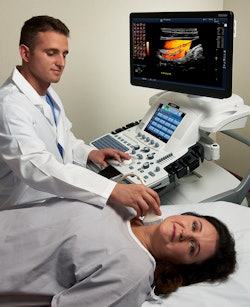 Logiq E9 XDclear 2.0 is the next generation of GE's Logiq E9 platform.
Logiq E9 XDclear 2.0 is the next generation of GE's Logiq E9 platform.Finally, the company is featuring its Scan Assistant tool, which helps sonographers scan more effectively by reducing keystrokes, shortening exam time and improving exam quality. It is also touting trophon EPR, an automated disinfection system for ultrasound probes that kills strains of human papilloma virus with a vaporized hydrogen peroxide solution.
Women's imaging
On the women's health side, GE is highlighting its eight-year collaboration with Institut Gustave-Roussy (IGR) in Villejuif, France. In 2004, the facility established a one-stop breast health clinic that uses a multidisciplinary, multimodality approach to diagnose women who arrive with suspicious breast findings.
The clinic features diagnostic imaging technologies from GE such as its Senographe Essential mammography unit, its SenoBright contrast-enhanced spectral mammography device, its SenoClaire digital breast tomosynthesis unit, and ultrasound and image-guided fine-needle aspiration.
GE and IGR commissioned an independent study of the facility's data from 11,000 women. They found that 75% of the women who arrived at the clinic received an accurate diagnosis and treatment plan the same day, they underwent fewer biopsies, and there was more than 80% patient satisfaction, according to the firm.
Molecular imaging
In molecular imaging, GE is focusing on telling the stories of customers that have improved their efficiency using the company's products. For example, one PET/CT site in Europe went from performing 12 studies a day to 25 by scanning patients in half the time with half the dose of radiopharmaceutical. The efficiency gains also translate to SPECT, where a user of GE's Discovery 670 Pro SPECT/CT system saw similar results.
On the product side, GE is talking up PET volume computer-assisted reading (VCAR), which the company said improves visualization and monitoring of disease progression or response to therapy. The application gives users the ability to compute standardized uptake values, measure metabolic activity and volume for areas of uptake on PET scans, and compare CT, PET/CT, and MR studies for baseline and follow-up studies.







